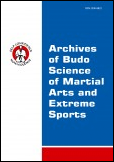2015, Volume 11, Issue 1
Habitual posture of fencers representing the Wielkopolska region
Mirosław Mrozkowiak1, Alicja Kaiser2, Marek Sokołowski3
1The Kazimierz Wielki University in Bydgoszcz, Department of Physiotherapy, Poland, Bydgoszcz, Poland
2WSB University in Poznań, Department of Tourism and Recreation, Poland, Poznań, Poland
3University School of Physical Education in Poznań, Department of the Methodology of Physical Education, Poland, Poznań, Poland
Author for correspondence: Mirosław Mrozkowiak; The Kazimierz Wielki University in Bydgoszcz, Department of Physiotherapy, Poland, Bydgoszcz, Poland; email: magmar54[at]interia.pl
Full text
Abstract
Background and Study Aim: It is well known that long-term sports training has the influence on body posture (long-term effects on the body-specific exercise). The issue is discussed on the example of competitive fencing. The aims of the paper was knowledge about habitual posture of fencers, type and degree of influence of fencing training on fencers’ body posture and also frequency of excessive values in spatial indicators describing fencers’ posture.
Material and Methods: The research was carried out in July 2013 among 23 fencers (mean age: 15 ±1.20 years; body height: 168.4 ±4.68 cm; body weight: 54.7 ± 8.26 kg). We measured 29 indicators in coronal, median and axial plane of pelvis and physiological spine curvatures. Selected indicators of the pelvis and spine were evaluated with use of a computer-based postural analysis. The most important in this method was that all measurements of spatial indicators were carried out simultaneously.
Results: In the plane median the competitive fencers reveal increase in length, height and angle of thoracic kyphosis, lumbar lordosis and trunk extension, maintaining at the same time optimal angle values of lumbar lordosis and thoracic kyphosis. In the plane coronal occur: increased shoulder asymmetry, distance from the line of spinous processes, and pelvis asymmetry also in axial plane.
Conclusions: Taking into consideration continuous increase in advancement and intensity of training, there appears a strong necessity for carrying professional diagnosis of health and body posture during periodic health examinations admitting to competitive sports. Developmental exercises and those improving aerobic capability are essential during the competitive fencing.
Key words: combat sport, kyphosis, pelvis, spine





